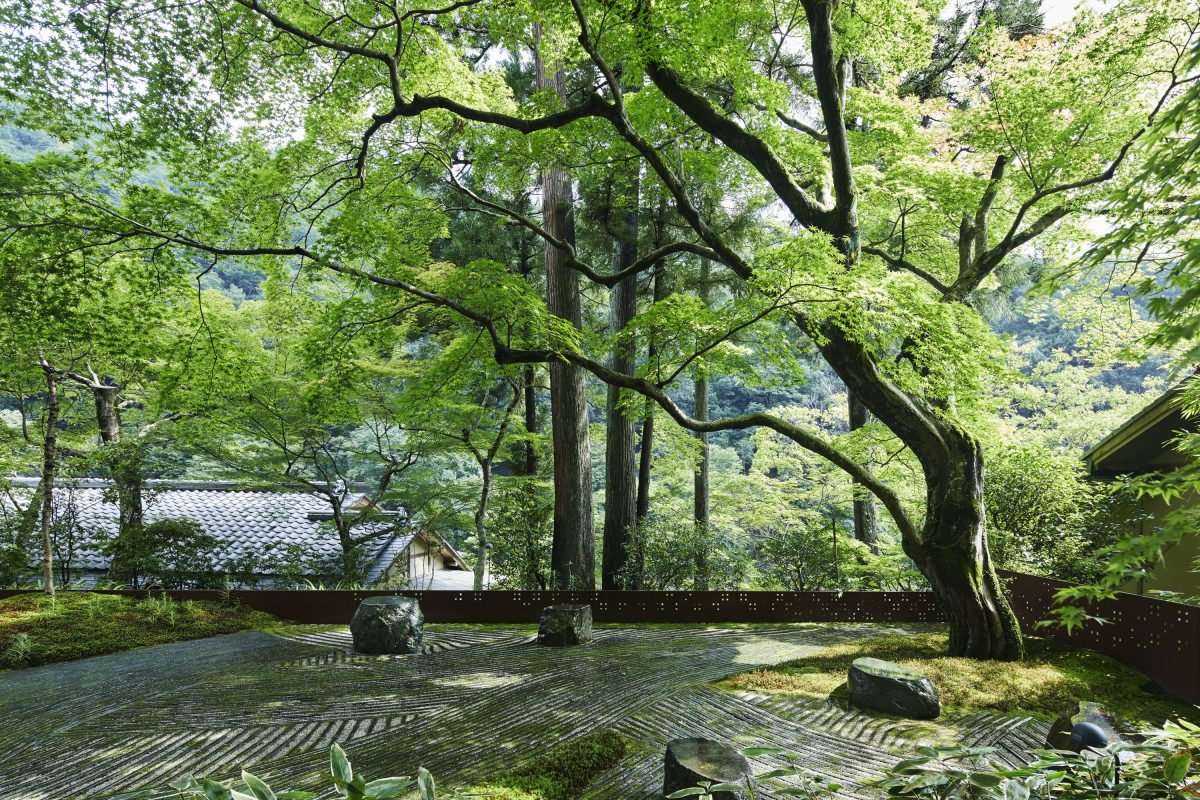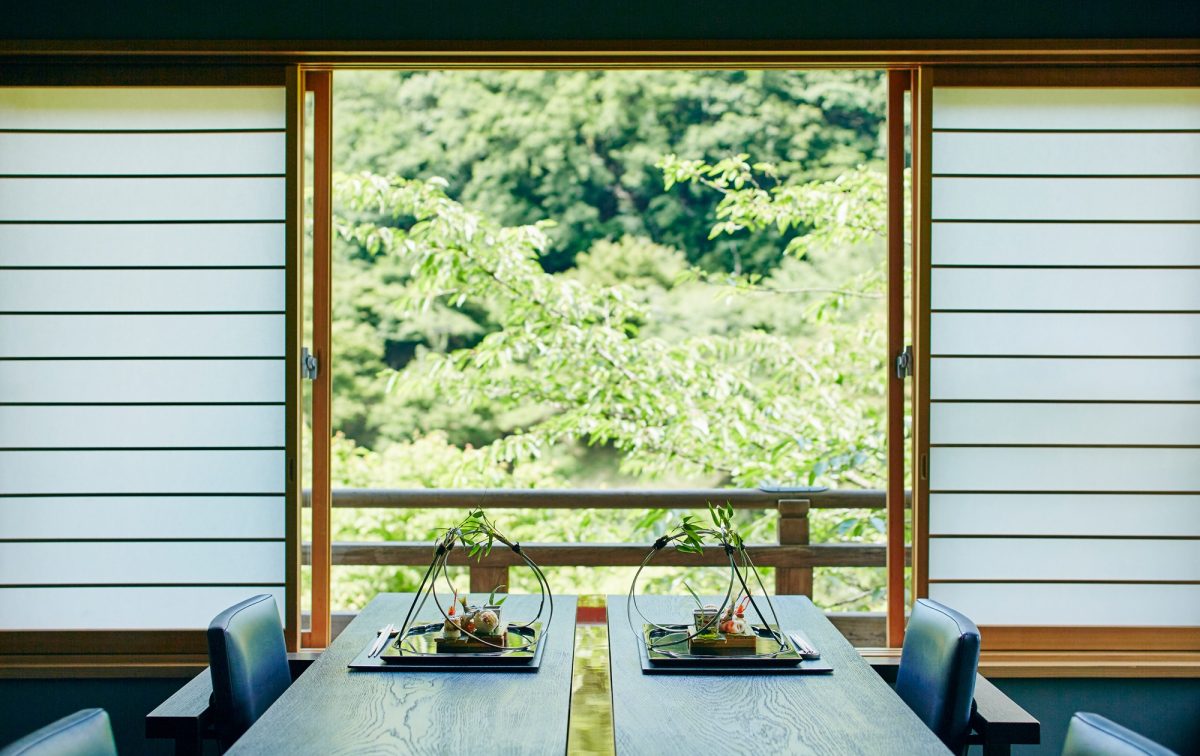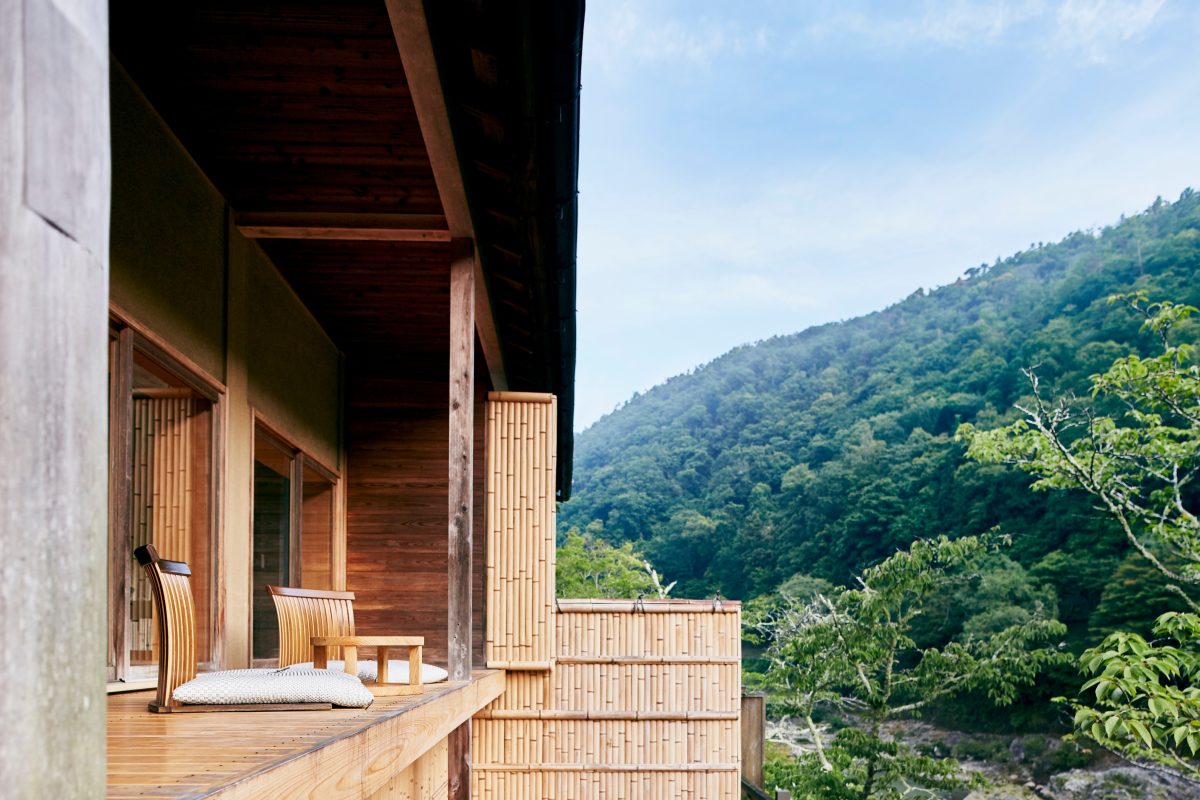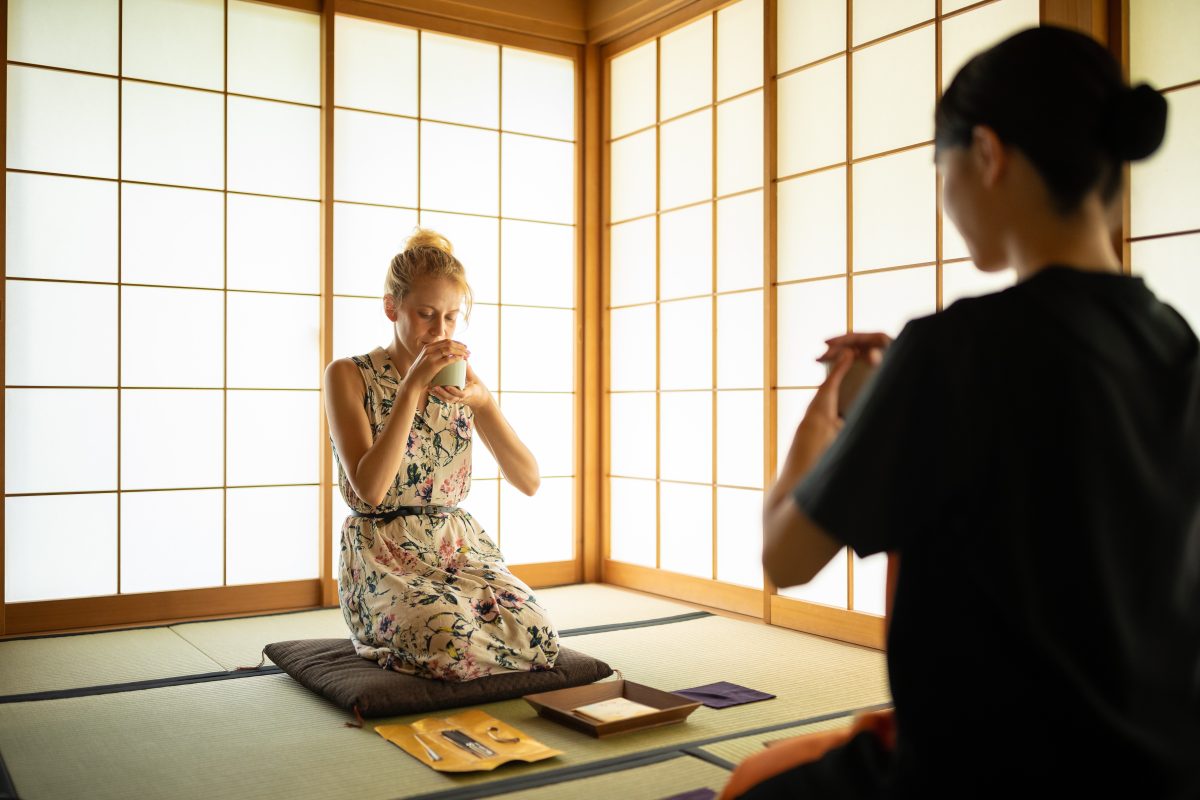
A picturesque nobles’ retreat in the millennial city of Kyoto
HOSHINOYA Kyoto in Arashiyama, Kyoto, is a ryokan (Japanese inn) with a river view from all rooms and is located in an area that was once flourished as a vacation home area for the Heian nobles. Whilst preserving the traditional Japanese architectural design and incorporating modern comforts, it opened in 2009. Away from the hustle and bustle near the Togetsu-kyo Bridge, a famous landmark of Arashiyama, HOSHINOYA Kyoto is 15 minutes by boat up the Oi River. Through the culture and traditions of Kyoto, the landscape that reflects the four seasons, immerse into a place where tradition and modernity intersect.
Design & Architecture
Architecture– Rie Azuma, Azuma Architect & Associates
Azuma started with a miraculously preserved historical ryokan inn in scenic Arashiyama that was built a century ago. Her goal was not to simply renovate it, but to study the essence of the original structure, then breathe new life into it in a way that would not only pay homage to the cultural richness of Kyoto, but also convey the elements that define HOSHINOYA.
Kyoto is still home to many artisanal design elements that have otherwise disappeared from Japan’s buildings—from Kyoto-style paper furnishings known as karakami to clay walls and Japanese tiles. It is one of few places in Japan that continues to preserve ancient traditions, yet, at the same time, it is a progressive city that actively incorporates and attempts to produce new and original ideas.
With HOSHINOYA Kyoto, Azuma has successfully preserved the lightness of Japanese wood architecture, the standalone structure of every guest room, and the mood evoked by the history of the villa, while infusing the entire resort with a sense of wonder and relaxation unique to HOSHINOYA Kyoto. The result is an entirely unique space, the likes of which cannot be found anywhere else.
Landscape – Hiroki Hasegawa, Studio on site
As the buildings and nature of Arashiyama are protected by regulations that prevent its historical scenery from being altered, Hasegawa developed a blueprint that would preserve the look of the area while pushing it forward into new aesthetic territory.
This is not an entirely novel concept. At the root of every traditional Japanese garden is a clash between two conflicting impulses: the desire to achieve perfection and the desire to create something new by destroying the old. Hasegawa has achieved a marvelous balance of the two, and the gardens of HOSHINOYA Kyoto reflect an originality and charm derived from the rich traditions of Kyoto.
HOSHINOYA finds inspiration in the traditions of Kyoto and, from that inspiration, attempts to create an entirely new culture. This can be seen in the imaginative elements scattered throughout the premises — such as a footpath rearranged as a garden with a terrace, and antiquated materials that have gone out of fashion repurposed as paths leading from doorways.
Lighting – Masanobu Takeishi, Illumination of City Environment, Ltd.
Takeishi tested a number of different lighting schemes that fused the traditional with the new, with a heavy focus on the way light presented and played with, the space and time of day. Utilizing light fixtures crafted by the artisans at Miura Shomei, the lighting evokes a mix of nostalgia and newness.
Guest Rooms
All 25 guest rooms have a view of the Oi River and Mount Ogura. There are 4 room types – Tsukihashi, Yamanoha, Tanigasumi, Mizunone. Enjoy the seasonal views of Oku-Arashiyama such as cherry blossoms in Spring, fresh green in the summer, colored leaves in autumn, and the snow views of winter.
Rooms embellished with kyo-karakami, Kyoto-style woodblock-printed paper
Kyo-karakami paper is characterized by beautifully hand-printed traditional patterns on high-quality washi, Japanese paper, such as torinoko paper. Blending pigments such as crushed white oyster-shell powder, red iron oxide, ultramarine, yellow ochre, India ink, and mica on a 130-year-old woodblock, the pigments are pressed onto the paper. Today, there are only two places in Kyoto that can create these kyo-karakami papers, and one of them, Kyo-karakami Maruni, is responsible for the paper used in the rooms of HOSHINOYA Kyoto. Each paper is made with the care and skill of an experienced craftsman, whereas no paper is exactly the same. As the sunlight touches the paper, the pigments shine, making the patterns look three-dimensional. The craftsmanship of Kyoto can be felt as one relaxes in the guest rooms during their stay.
Food & Beverages
Kaiseki Dinner Course - Flavors and expressions reflecting the season and culture
At HOSHINOYA Kyoto, surrounded by the mountains of Arashiyama, guests can enjoy the changes of the four seasons with their five senses. For guests to have an enjoyable stay at this location, changes in nature according to the Japanese calendar and seasons are valued and hence reflected in the dishes. For spring, the coming of spring is expressed using bitter flavors and soft, fresh scents and for the summer, the cool is represented using ingredients, plates, and aesthetics. Earthy scents of the mountain are captured to show the fruitful landscape of autumn and lastly for winter, the root vegetables, where sweetness increases during winter, are used to bring out nutritious and rich flavors. Moreover, based on the idea, dosan-dohou, which means cooking using the local method for local ingredients. Producers know the best way to cook the ingredients, so these methods are incorporated into how the dishes are prepared at the dining of HOSHINOYA Kyoto.
Overview of HOSHINOYA Kyoto Dining
Opening hours: 5:30 pm to 7:30 pm (Last entry)
Price: 24,200 JPY per person (tax and service charge included)
Special Facilities
Floating Tea Room
To appreciate the four seasons, special front row seats of the Oi River are present as a wooden deck extends towards it, feeling as if one is floating over nature. Encounter moments of each season as cherry blossom viewing in Spring, trolleys running through the green maple leaves in Summer, autumn leaves of Mt. Ogura and the serene snowscape of winter awaits.
Gardens of HOSHINOYA Kyoto
Kyoto has many famous Japanese gardens and it has been preserved for many years. At the core of the landscape design of HOSHINOYA Kyoto, these traditions make it possible for new challenges to be expressed. Find peace in our gardens that combines the innovative landscape design by Hiroki Hasegawa, President of studio on site, and traditional gardening techniques by Ueyakato Landscape. One of the gardens, the Hidden Garden, uses smoked roof tiles and white sand to represent a landscape that is similar to karesansui, a Japanese dry garden or Zen garden, whilst creating a space that invites one into the garden. Karesansui is a type of Japanese garden that illustrates movement of water using rocks and white sand in a place with no water. Guests can enjoy the view of the Oi River and Arashiyama while walking in the garden and it is designed in a way that guests can gather in the garden, where people become part of the garden scenery.
Experiences
Monko
Monko is a type kodo (or incense ceremony), a traditional Japanese culture along with flower arrangement and tea ceremony. It is a practice (or game) where participants “listen” to the faint scent of fragrant wood as they spend time focusing on the scent. It is said that this elegant and intellectual game began in the Muromachi period (1336 – 1573). This is an accessible introductory course of Monko using authentic tools and precious fragrant wood.
Date & Time: Daily from 4:00 – 4:40 pm
Price: 3,388JPY per person (tax and service charge included)
Reservation: Required in advance
Morning Temple Worship
This morning ritual is an experience to adjust one's mind under the clear air early in the morning at a Zen temple in Kyoto. Start the day by adjusting the posture to sit in Zen meditation and listen to the readings by the Buddhist priest. Later, listen to a Dharma sermon with a cup of matcha green tea made by the priest.
Date & Time: Daily from 5:00 am – 8:00 am *Starting time varies depending on the time of year
Price: 15,427 JPY per person (tax and service charge included)
Reservation: Required a week in advance
Overview of HOSHINOYA Kyoto
Address: 11-2 Arashiyama Genrokuzancho, Nishikyo-ku, Kyoto 616-0007
Number of Rooms: 25
Check-in: 3:00 pm/Check-out: 12:00 pm
Price: Starting from 136,000 JPY per night per room (includes tax and service charge, excludes meals)
Directions: Approximately 10 minutes by walk from Arashiyama Station (Hankyu Line)
About HOSHINOYA Brand
Luxury hotel embodying the true characteristics of land, history, and culture
HOSHINOYA is an accommodation with distinct themes, conceptualized from each location's land, history, and culture. Woven into these distinct themes is our attention to detail in every aspect from the design to hospitality; contributing to the creation of a one-of-a-kind world of HOSHINOYA. Enrich the heart with the epiphanies of travel through a unique stay experience.
About Hoshino Resorts
Hoshino Resorts was first established as a Japanese inn/ryokan in 1914 in Karuizawa in Nagano Prefecture before it began the operation of other resorts in Japan. Today, it has evolved into a highly influential hotel management company and is run by 4th-generation family member Yoshiharu Hoshino. Providing a unique experience focused on the local charms of each destination and a high level of omotenashi, Japanese-style hospitality, the company has expanded rapidly out of Karuizawa since 2001 and now operates more than 60 accommodations both in and outside Japan with one of the following categories: luxury hotel brand “HOSHINOYA,” hot spring ryokan brand “KAI,” countryside resort hotel brand “RISONARE,” city tourism hotel brand “OMO,” free-spirited hotel brand “BEB,” or other unique lodgings.